The constructional overview of the induction motor
The induction motor has a stator and the rotor as its major parts. The stator is a stationary part, and the rotor is a rotating part. The stator of the motor has overlapping coils that are physically placed 120 degrees electrically apart. When the stator is connected to the three-phase supply source, a rotational magnetic field of constant magnitude and a varying direction is produced. The flux produced in the stator travels through the air gap and gets linked to the rotor conductors.
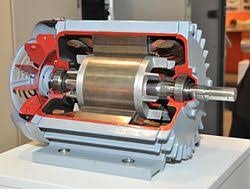
The rotor winding is short-circuited through end rings or connected to the external resistance. The linking flux of the stator induces EMF in the rotor circuit, and the current starts flowing in the short-circuited rotor winding because of the induced EMF in the rotor. Due to the rotor current and main flux interaction, the torque is produced, and the motor starts rotating.
In the stator, the electric energy converts into magnetic energy.
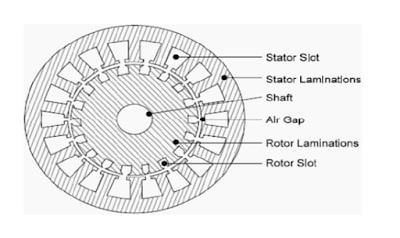
The magnetic energy travels through the air gap of the motor. The air gap increases the reluctance of the magnetic circuit.
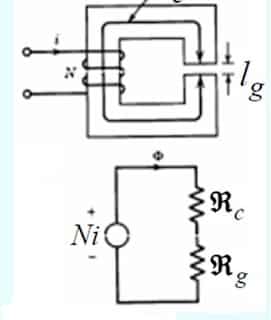
Equivalent Electrical circuit of the magnetic Circuit
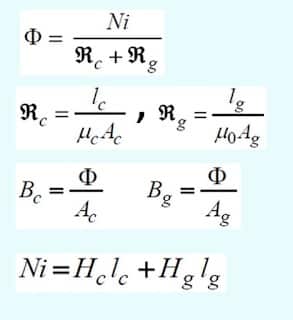
Where,
Rc and Rg are the reluctance of the magnetic and the sir gap circuit.
The air gap plays a significant role in the performance of the motor.
Length of Air-Gap
The air gap length affects the following performance parameters of the induction motor.
- Magnetizing current
- Power factor
- Overload Capacity
- Cooling
- Noise
Magnetizing Current and Power Factor
The magnetizing current of the motor depends on the specific magnetic loading and the air gap length of the machine. A large air-gap length leads to a higher magnetizing current and poor power factor.
A large air-gap length increases the reluctance of the magnetic flux path. The reluctance of the magnetic circuit is similar to the resistance of the electric circuit. The reluctance of a magnetic circuit is;
R=MMF/Φ —–(1)
Also,
R= L/μA ——-(2)
MMF=RΦ
Φ =MMF/R
Φ =MMF*(μA /L) —–(3)
Where,
R = Reluctance of the magnetic circuit
MMF = Magnetomotive force(MMF=NI)
L = length of the air gap
Φ = Flux in the air gap
μ = Permeability of the magnetic material
Equation (3) clearly shows that the MMF required for producing and sending the flux through the air gap depends on the flux density and the air-gap length.
If the air gap length is increased, the magnetic circuit’s reluctance will increase. This increase in reluctance will demand more magneto-motive force to produce the required flux in the motor. To meet the additional requirement of MMF, the stator magnetizing current increases.
The motor’s power factor worsens with an increase in magnetizing stator current. The phasor diagram of the motor having small and large air gap lengths is shown below. The relationship between the air gap length and the power factor can be well understood with the following phasor diagram.
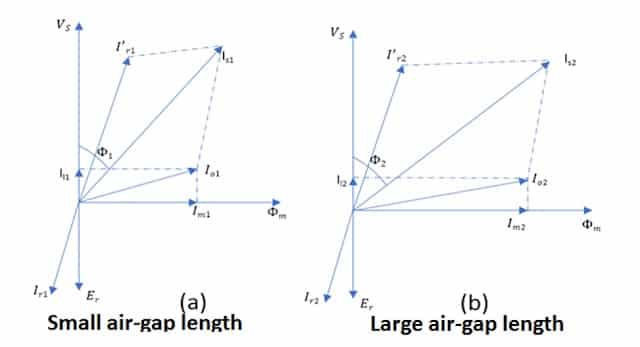
The air gap length in Fig (b) is more than the air gap in Fig (a). The angle between the applied voltage and the stator current is greater in Fig (b) than in Fig (a). With an increase in air gap length, more magnetizing current is required to produce the rated flux in the magnetic core, and the phase angle between the applied voltage and the magnetizing current increases. As a result, the power factor becomes low.
Overload Capacity
The leakage flux is reduced with an increase in air gap length. The flux produced in the stator winding gets almost fully coupled with the rotor winding if the air gap length is more. Therefore, the overload capacity of a large air gap length motor is more than that of a motor with a small air gap length. With increased air gap length, the leakage reactance decreases, and the overload capacity increases.
Cooling
With a large air gap length, the stator and the rotor are separated by a large distance, so cooling is better. The copper loss(I2*R Loss) occurs in the stator and rotor winding, and the iron loss occurs in the core. The heat is quickly transferred if the motor has a large air gap. The winding insulation can be used in the H or F classes with a temperature rise limit to the B class if the air gap length is greater.
Noise
The leakage flux gets reduced with a large air gap length. Less noise is generated in the motor with a longer air gap.
Tooth Pulsation Loss
The tooth pulsation loss reduces in a large air gap length motor because of a small variation in the reactance of the air gap.
Unbalanced Magnetic Pull
An unequal air gap causes an unbalanced magnetic pull. The unbalanced magnetic pull acts in the direction of the shortest air gap.
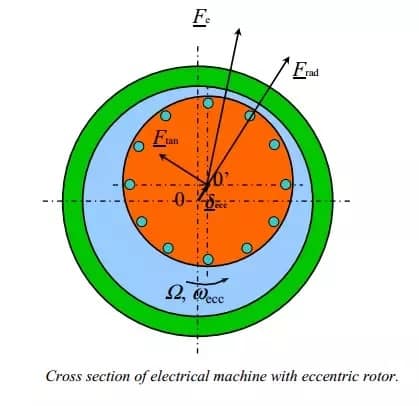
The unbalanced magnetic pull can be minimized by tight tolerances or by making the air gap large within all design constraints.
A motor with a small air gap length draws less magnetizing current, and the motor’s power factor is better than a motor with a large air gap length.
What should be the optimum air gap length?
Unlike in a transformer, it is impossible to have zero air gap for a rotating machine. The rotating machine must have an air gap for its rotation. The optimum air gap of an induction motor can be expressed by the following empirical formula.
lg = 0.2 + 2√ LD mm
Where,
lg = Air gap Length (mm)
L = Stator core Length(Meter)
D = Internal diameter of the Stator core(Meter)
Example:
If the stator core length and diameter are 0.18 meters and 0.34 meters, respectively, the air gap length between the stator and the rotor
lg = 0.2 + 2√ LD mm
= 0.2 +2√0.18*0.34
= 0.2 +0.494
= 0.694 mm
The designer keeps the minimum air gap length in the energy-efficient motors to improve the power factor and reduce the no-load losses in the motor.
very nicely explained about the importance of air gap in an Induction machine.i would like to know about compensation technique in DC machines.